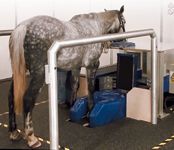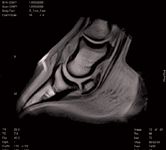The ups and downs of equine MRI in veterinary medicine
A look at the pros and cons of standing vs. recumbent magnetic resonance imaging systems.
Magnetic resonance imaging (MRI) was first performed on live horses at Washington State University's College of Veterinary Medicine in the late 1990s. Available for almost 15 years, this diagnostic modality has seen a steep increase in clinical use during the past five years. MRI images have expanded our thinking on many types of equine lameness and greatly improved veterinary diagnostic ability.
MRI equipment and processing technology have significantly improved during this time period as well. Clinicians now have a number of choices to make when contemplating obtaining an MRI evaluation of a patient, including the type of machine, magnet strength, image quality, anesthesia risk and a number of other factors.

A standing sedated horse getting an MRI scan of its right distal forelimb. Scans such as this can produce good images of the navicular bone, coffin joint, pastern, fetlock and associated ligaments and related structures in the lower limb. (PHOTO COURTESY OF ROSSDALE & PARTNERS, NEWMARKET, U.K.)
A look at your options
Bigger is generally better, and in the case of MRI, bigger is measured in teslas. MRI machines come in three different sizes based on the magnet's strength, which is measured in tesla units or Ts; 1 T is nearly 30,000 times stronger than the earth's gravitational pull. High tesla values can be obtained by placing a magnetic field in a confined or enclosed space.
Equine MRI evaluations are generally done with one of three types of systems. There are two high-field systems, which have 3-T and 1.5-T magnets, and a low-field system with a 0.27-T magnet. To get stronger magnetic fields and higher teslas, MRI units have been designed in a tubular shape with a core space that decreases as magnetic field increases. The 3-T and 1.5-T units are generally known as "down" magnet systems because the horse must be anesthetized to have its distal limbs or head and neck safely placed as deeply as possible into the machine's tubular core. Horses do not like the somewhat claustrophobic aspect of the magnetic coil or the recumbent positioning, so anesthesia is required.
Additionally, in order to get an optimal scan with high-field systems, there must be minimal to no motion. Even a fully anesthetized horse will still have some limb movement because of its heartbeat and respiratory efforts, but this is controlled in down MRI systems by padding and careful positioning.

An MRI view of a hoof taken with a standing MRI showing a problem with the deep digital flexor tendon within the hoof. Newer motion-reducing software has greatly advanced the quality of scans taken in the standing horse to the point where diagnostic rates for lesions in the distal limb are very comparable between "up" and "down" MRI systems. (PHOTO COURTESY OF HALLMARQ VETERINARY IMAGING)
The 0.27-T MRI is referred to as an "up" or "standing" MRI. This low-field system features a more open C- or U-shaped clam shell design, and a sedated horse is kept standing as the magnetic coil is placed around its leg, foot or other affected area. Each system has distinct strengths and weaknesses, and these MRI units have been in use long enough now to make an interesting and informative comparison.
High-field pros and cons
The primary advantage of the high-field system is image quality. Large tesla machines will produce a more detailed image of a larger area in a single scan, giving the clinician a clearer look at a horse's anatomy, generally leading to optimum diagnosis.
Numerous research projects have evaluated equine distal limb images produced from cadaver forelimbs using 3-T, 1.5-T and 0.27-T systems. There is no disagreement that larger units produce more detailed images. A study comparing the three different types of equine MRI units concluded that "anatomical structure scoring values of images obtained with 3 T and 1.5 T were significantly greater than scores of images obtained at 0.27 T."1 Not surprisingly, this research also indicated that 3-T images scored significantly higher than 1.5-T images.
The main disadvantage of high-field systems is that patients must be anesthetized. Many horses that are being considered for MRI evaluation have an injury or some degree of lameness that has led to the need for diagnosis. Clinicians often have concerns about the induction and recovery aspects of general anesthesia and the potential risk to an already compromised horse. Many owners share this concern, and horses with noncrucial problems or non-life- or career-threatening problems may not be evaluated by MRI because of anesthesia concerns. In these cases the information potentially gained is not judged to be worth the risk.
MRI may also be excluded in sports medicine evaluation of elite performance horses. Subtle issues could be identified and treated to yield even better performance, but owners and trainers are reluctant to risk anesthesia on a still highly functional equine athlete. A recent report on equine perioperative fatality rates concluded that there is a 1 percent risk of death from anesthesia in healthy horses.2 Older horses and horses with pulmonary, cardiovascular, metabolic or musculoskeletal issues had a higher degree of risk. Those percentages are significant in the eyes of many owners, and high-field systems may consequently not be fully utilized.
Low-field pros and cons
Low-field MRI systems do not carry an anesthesia risk, but traditionally these units have not been seriously considered as diagnostic options because of their lower decreased image quality. Scanning for longer time periods allowed these lower-T systems to improve image quality, but longer scans in standing tranquilized horses meant more potential swaying motion, which ultimately negated any image improvement.
However, significant advances have been made to low-field MRI systems in the past few years. Hallmarq Veterinary Imaging, the only manufacturer of MRI systems for the standing horse, has introduced 0.27-T scanners internationally that use improved software features to help control motion and provide other improvements that now may make standing MRI a viable choice.
An investigation of these newer motion-correction techniques for standing equine MRI outlined the promise of standing MRI saying, "MRI of the distal extremities of the standing, sedated horse would be desirable if diagnostic quality images could be obtained. With the availability of extremity and special purpose magnet designs on the market, a system to safely accommodate the standing horse may gain increasing popularity."3
The study tested a number of motion correction techniques on scans of the carpus and tarsus in five standing sedated horses. It is significant that this research was done on carpal and tarsal scans since these relatively more proximal joints are usually associated with more "wobble motion" than distal limb structures, which are far more commonly imaged with MRI. Standing MRI scans of the equine foot, pastern and fetlock already have generally good diagnostic correlation to high-field scans because of the decreased motion seen in the distal limb. This study, however, concluded that in standing MRI scans of the equine carpus and tarsus, "the motion artifacts were nearly eliminated. Although significant hurdles remain, these results suggest promise for allowing diagnostic quality MRI of the carpus and tarsus in the standing horse."3
So which system to pick?
Still there is the question of low-field image vs. high-field image since MRI is, at the core, a diagnostic tool, and the image produced must be diagnostic.
In the study that compared 3-T, 1.5-T and 0.27-T systems, it was certainly shown that bigger units produced significantly "better" images. And "better" generally means clearer and more distinct images with a more pronounced differentiation to object edges and sharper contrast. Sometimes, however, "better" is in the eye of the beholder since different clinicians prefer radiographic or ultrasonographic images produced by certain machines, while other clinicians may prefer images from other machines. But these researchers also stated, "The images from all of the examinations (3T, 1.5T and 0.27T) were considered to be of diagnostic value."1 Exceptions were made for the dorsal/distal aspect of the hoof capsule, which did not image clearly in the low-field system.
These findings suggest that standing MRI may in fact be a reasonable diagnostic choice for a number of clinical cases. Standing MRI eliminates the need for general anesthesia, and this reduces not only the cost but the risk of complication or death.
Some anatomical areas and particular lesions such as the dorsal/distal aspect of the hoof capsule referenced above and articular cartilage defects in areas of joints where this tissue is very thin (the thinner the structure, the more difficult it is to scan, and larger units will generally give a more useful image) will always require a high-field system MRI scan for accurate and complete diagnosis. Subtle cartilage damage may be beyond the diagnostic capabilities of low-field systems, but navicular bone degeneration, deep digital flexor tendinitis, collateral ligament desmitis, phalangeal bone bruises, navicular collateral desmitis, corns, fractures and other issues of the foot along with similar problems of appropriate structures in the pastern, fetlock and now even the hock and carpas can be noted on the newer, improved up-MRI unit. These advantages may make standing MRI even more popular, and emerging technological advances will only continue to improve image quality to a point where "up" or "down" may no longer be a debate.
Dr. Kenneth Marcella is an equine practitioner in Canton, Ga.
References
1. Bolen G, Audigie F, Spriet M et al. Qualitative comparison of 0.27T, 1.5T, and 3T magnetic resonance images of the normal equine foot. J Equine Vet Sci 2010;30(1):9-20.
2. Johnston GM, Taylor PM, Holmes MA, et al. Confidential enquiry of perioperative equine fatalities (CEPEF-1): preliminary results. Equine Vet J 1995;27(3):193-200.
3. McKnight AL, Manduca A, Felmlee JP, et al. Motion-correction techniques for standing equine MRI. Vet Radiol Ultrasound 2004;45(6):513-519.